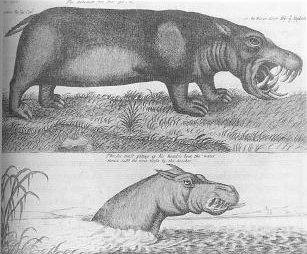Yesterday, the Clever Wife and I went over to Sequim (pronounced "skwim") to look at some land. We didn't buy any land, but we did get to take an extra moment to visit the little museum in Sequim and look at their mastadon. I've written a lot about mammoths, but I havent said much about their cousins, the mastadons.
Despite their superficial resemblance, mastodons are only a distant relative of mammoths. Mastodons separated from the earliest elephants millions of years before African and Asian elephants separated from each other or mammoths separated from Asian elephants. Mastodons probably entered the new world at the beginning of the ice age and spread all of the way into South America, where they split into a number of species. The mammoths entered the new world later, during interglacials of the ice ages.
Mastodons have teeth that are dramatically different from those of elephant/mammoths. Mammoth teeth are giant grinders suited to grazing on the grasses and low shrubs that they found on the prairies, steppes, and tundras where they usually lived. Mastodons had pointed teeth. This led the first scientists who described them to believe they were carnivores, terrible monsters much like the oliphaunts of Mordor. I'm not sure if it was homework or imagination on Peter Jackson's part, but some mastodons also had two sets of tusks, just like the oliphaunts in Return of the King. Later, scientists discovered that mastodons were browsers, who lived in the forest and ate tough branches and cones of conifers. Big, pointed teeth are useful for tearing branches and cones apart.
The idea that mastadons were carnivores wasn't a wild idea on the part of eighteenth century naturalists. They believed mastodons were carnivores because mastodon teeth were almost identical to hippo teeth, and they believed hippos were fierce carnivores. Pointed teeth were considered to be a sign of meat eating. More than that, hippos are extemely dangerous animals in the wild. In an average year in Africa, hippos kill a far larger number of humans than any other mammal, except other humans. Hippos are short-tempered, huge animals that spend most of their days beneath the surface of shallow waters. When boats or swimmers pass overhead or near-by, they respond to the potential threat by snapping at them with their enormous jaws. It's a defensive action, not a hunting action, but that is small consolation to the families of those who were bitten in half or to those who were bitten.

Since antiquity, the only thing that most of the world outside of Africa knew about hippos were that they were big and dangerous. The occasional huge bone or sharp tooth that made it to the Mediterranean only served to confirm the image of hippo fierceness. Most experts believe that the Behemoth in the Old Testement book of Job is probably a garbled description of a hippo. The parts of the world where hippos are common were not penetrated by outsiders before the nineteenth century. A live hippo didn't make it to Europe until the 1840s.
Ken Ham, the founder and director of the young earth creationist group Answers in Genesis, points out that Job 40:15-24 descibes Behemoth as having a "tail like a cedar." The Bible is the word of God, who is infaliable. Therefore, it is not possible for a book of the Bible to include a garbled description of any animal. Hippos have small tails. According to Ham, this means Behemoth was not a hippo; it was probably a brachiosaurus. And, brachiosauri were among the passengers on the ark of Noah, because God told Noah to take up "every kind of animal" not just some animals. If dinosaurs ever existed, they were on the ark and only went extinct after the flood. Ham believes that some kinds of dinosaurs might still be alive out there, waiting to be discovered.
Scholars of Biblical high criticism (studying it as a literary text) usually laugh until coffee comes out of their noses when they hear the tail argument. These scholars believe that the tail of Behemoth is a metaphor for something else. The complete desciption of Behemoth in Job is as follows:
15 Behold now behemoth, which I made with thee; he eateth grass as an ox.
16 Lo now, his strength [is] in his loins, and his force [is] in the navel of his belly.
17 He moveth his tail like a cedar: the sinews of his stones are wrapped together.
18 His bones [are as] strong pieces of brass; his bones [are] like bars of iron.
19 He [is] the chief of the ways of God: he that made him can make his sword to approach [unto him].
20 Surely the mountains bring him forth food, where all the beasts of the field play.
21 He lieth under the shady trees, in the covert of the reed, and fens.
22 The shady trees cover him [with] their shadow; the willows of the brook compass him about.
23 Behold, he drinketh up a river, [and] hasteth not: he trusteth that he can draw up Jordan into his mouth.
24 He taketh it with his eyes: [his] nose pierceth through snares.
Now, dear students, by carefully reading verses 16 and 17 (Lo now, his strength [is] in his loins, and his force [is] in the navel of his belly. He moveth his tail like a cedar: the sinews of his stones are wrapped together.), what do you think tail and stones are a metaphor for? That's right, kids. You might have dirty minds, but you are better Biblical scholars that Ken Ham.
I'll have more to say about mammoths and mastodons in the Northwest at a later date.




No comments:
Post a Comment